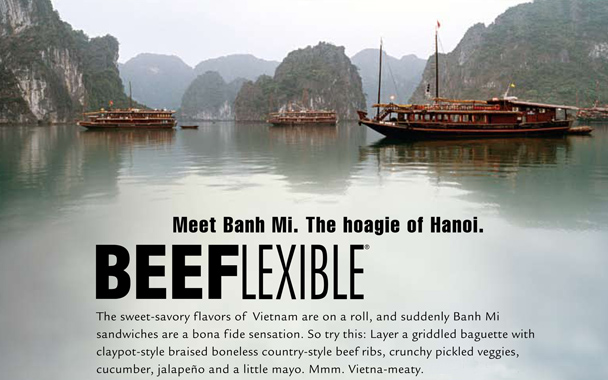Every little Vietnamese restaurant in Paris (and there are many) used to serve a couple of hearty meat-and-noodle concoctions called soupe hanoïenne and soupe saigonienne—named, of course, for the then-capitals of North and South Vietnam, respectively. One late April day in 1975, I happened to be dining with a French friend at one such establishment when we heard the news that Saigon had just fallen to the North. My friend looked up from his menu and cracked, “Well, they’re all in the same soup now.”
Though it applied to a different foodstuff, for some reason I remembered his remark when I opened a copy of the foodservice trade publication Nation’s Restaurant News recently to find a full-page ad headlined, “Meet Banh Mi. The hoagie of Hanoi.” The ad, sponsored by the Cattlemen’s Beef Board and the National Cattlemen’s Beef Association, went on to urge readers to “Beeflexible,” adding that “The sweet-savory flavors of Vietnam are on a roll [get it?], and suddenly Banh Mi sandwiches are a bona fide sensation.” There followed a recipe for constructing one with “claypot-style braised boneless country-style beef ribs,” along with the promise that the results would be, er, “Vietna-meaty.”
Banh mi is one of the world’s great sandwiches, a genuine example of culinary-cultural fusion with a lot going on in both flavor and texture. Its framework is a crusty, smallish—okay, hoagie-size—baguette (the word banh comes from pain, French for bread, and banh mi means the loaf as well as the sandwich), traditionally filled not with beef but with pork, typically in the form of pork roll (sort of a Vietnamese luncheon meat), grilled or roasted pork loin, or pâté. The sandwich is rounded out with cilantro, chiles, and some combination of onions, cucumber, and pickled daikon and/or carrots, and the principal dressing is mayonnaise—in Vietnam, often a version made partially with butter.
The virtues of banh mi aside, though, the breezy tone of the “Beeflexible” ad bothered me at first. To Americans of my generation, the Vietnam war was a divisive, horrific conflict. We demonstrated against it (or for it) and argued violently about it with our parents and teachers and peers; we lost family and friends to it; whether we served in the war or not, it changed our lives forever. The flavors of Vietnam, to us, were more likely to be bitter than sweet-savory.
But then something else occurred to me: That so many Americans enjoy Vietnamese food, sandwiches and otherwise, today is a good thing, not just for our palates but for what it says about the healing powers of passing time. And that American beef ranchers, in promoting their own product, can celebrate banh mi suggests how far our whole country, heartland and all, has come in the past 30-plus years. I don’t even mind the awful wordplay; in a way, it just stresses how fully our perceptions have changed. Whether or not we’re all in the same soup, I think it’s pretty good news that we’re all eating the same sandwiches.

